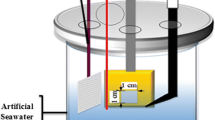Abstract
This paper reports a voltammetric study of bronze in synthetic seawater (SSW). The effects of buffering and deoxygenating were particularly visible in the transpassive region. The breakdown of the anodic passive film on bronze leads to a well-defined activation peak in the transpassive region typical of a nucleation and growth of pits. The breakdown potential of the passivity was shown to vary with the experimental conditions, namely, with buffering and deoxygenating. Buffering has shown to lead to more stable passive films and deoxygenating to higher oxidation currents. Scanning electron microscopy with energy dispersive spectrometer (SEM/EDS) studies of bronze samples with 1-month exposure in non-deoxygenated buffered and non-buffered SSW under open circuit potential have shown significant differences in their morphology: a uniformly cracked surface and a surface showing large and spherical precipitates of about 50 μm uniformly distributed along the surface, respectively, for bronze coupons in buffered (pH 9) and in non-buffered SSW. The EDS technique has identified Cu, O, Cl and Na on the corrosion products of bronze in non-buffered SSW, whilst in buffered media, Sn was also identified. In non-buffered media, open circuit potentials have shown to be all the time less negative than in the buffered media. After 1-month exposure the E OCP of bronze samples in both media seem to converge to −0.131 and −0.155 V vs Ag|AgCl, respectively. This potential can be assigned to the formation of cuprite, Cu2O and nantokite, CuCl. The analysis of the SEM images after the removal of the corrosion products has shown descuprification with higher intensity on the surface from coupons in non-buffered SSW.










Similar content being viewed by others
References
Robbiola L, Blengino JM, Fiaud C (1998) Corros Sci 40:2083
Sutter EMM, Millet B, Fiaud C, Linco D (1995) J Electroanal Chem 386:101
Chialvo MRG, Marchiano SL, Arvia AJ (1984) J Appl Electrochem 14:165
Chialvo MRG, Salvarezza RC, Vazquez Moll D, Arvia AJ (1985) Electrochim Acta 30:501
Modestov AD, Zhou D, Wu Y-P, Notoya T, Schweinsberg DP (1995) Corros Sci 36:193
Fonseca ITE, Marin ACS, Sá AC (1992) Electrochim Acta 37:2541
Fonseca ITE, Sá AIC (1995) In: Ferreira MGS, Simões AMP (eds) Electrochemical methods in corrosion research. Trans Tech Publications, Materials Science Forum, Switzerland, p 511
Milosev I, Melikos-Hukovic M, Drogowska M, Ménard H, Brossard L (1992) J Electrochem Soc 139:2409
Fonseca ITE, Domingues IMB (1994) Corr Prot Mat 13:24
Deslouis C, Tribollet B, Mengoli G, Musiani MM (1988) J Appl Electrochem 18:384
Duthil J-P, Mankowski G, Giusti G (1996) Corros Sci 38:1839
Edwards M, Rehring J, Meyer T (1994) Corros Sci 50:366
Ferreira JP, Rodrigues JA, Fonseca ITE (2004) J Solid State Electrochem 8:260
Souto RM, Gonzalez S, Salvarezza RC, Arvia AJ (1994) Electrochim Acta 39:2619
Debiemme-Chouvy, Ammeloot F, Sutter EM (2001) J Applied Surf Sci 174:55
Ammeloot F, Fiaud C, Sutter EMM (1999) Electrochim Acta 44:2549
Mabille I, Bertrand A, Sutter EMM, Fiaud C (2003) Corros Sci 45:855
Souissi IN, Bousseimi L, Khosrof S, Triki E (2004) Mater Corros 55:284
Mansfeld F, Little B (1992) Electrochim Acta 37:2291
ISO/DIS 8407 (1986) Metal and alloys-procedures for the removal of the corrosion products from corrosion tests specimens. Geneve, Switzerland
Díaz R, Diéz-Pérez I, Gorostiza P, Sanz F, Morante JR (2003) J Braz Chem Soc 14:523
Acknowledgements
The authors thank Fundação para Ciência e Tecnologia (FCT) for providing financial support to Centro de Electroquímica e Cinética da Universidade de Lisboa (CECUL) Research Unit POCTI/301/2003 (vertente FEDER) We are grateful to Mrs. Paula Menezes from Laboratório Nacional de Engenharia Civil (LNEC) for all the assistance in the SEM/EDS studies.
Author information
Authors and Affiliations
Corresponding author
Rights and permissions
About this article
Cite this article
dos Santos, L.M.M., Lemos Salta, M.M. & Fonseca, I.T.E. The electrochemical behaviour of bronze in synthetic seawater. J Solid State Electrochem 11, 259–266 (2007). https://doi.org/10.1007/s10008-006-0102-6
Received:
Revised:
Accepted:
Published:
Issue Date:
DOI: https://doi.org/10.1007/s10008-006-0102-6




